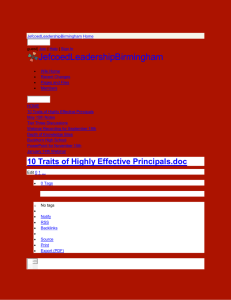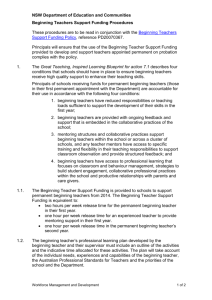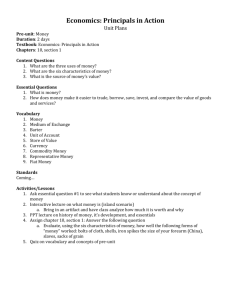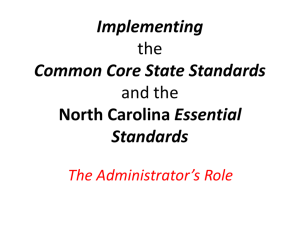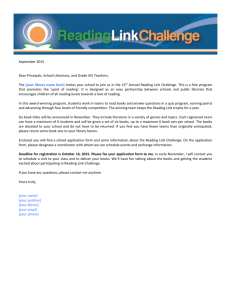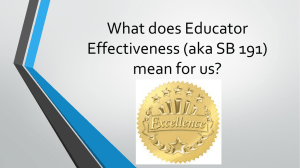0.21 0.12 - Utah PTA!
advertisement
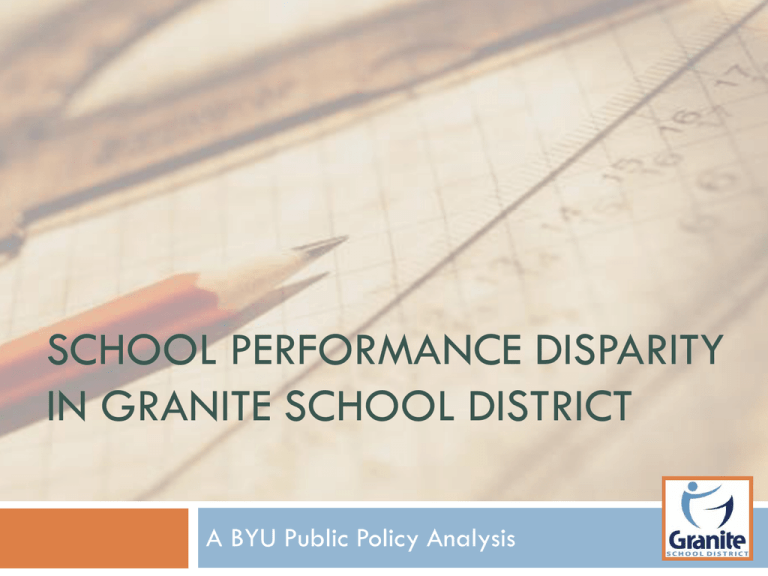
SCHOOL PERFORMANCE DISPARITY IN GRANITE SCHOOL DISTRICT A BYU Public Policy Analysis Problem Statement Why do elementary schools with similar levels of students participating in the free and reduced lunch (FRL) program have varying levels of student achievement? Task: determining why these variations exist and whether they are a concern School Performance by FRL 100% Upper Limit 90% 80% Fitted Values CARL SANDBURG WESTBROOK 70% MONROE SPRING LANE Lower Limit HUNTER 60% GOURLEY 50% BACCHUS BEEHIVE BRIDGER JACKLING 40% 0% 10% 20% 30% 40% 50% 60% 70% 80% Percent of School on Free or Reduced Lunch 90% 100% Proficiency Differences High Performance Difference Low Performance Spring Lane 19% Bacchus Westbrook 22% Jim Bridger Carl Sandburg 20% Beehive Hunter 18% Jackling Monroe 15% David Gourley Education Research School Characteristics ELL Parental Involvement Class size Interventions Technology Principals Extra curricular activities “Liking” school Types of engagement Quantitative Data Key Variables: Percent proficient Percent of school on free or reduced lunch Other explanatory variables: Student-teacher Mobility rate Percent ELL Year-round PTA ratio Percent White ratio Variables Used in Quantitative Analysis Mean Standard Deviation Min Max n Proficiency 0.64 0.12 0.47 0.98 61 FRL 0.61 0.25 0.07 0.99 61 Student-Teacher Ratio 25.68 1.74 22.90 31.40 61 Mobility 41.21 19.23 9.05 88.03 60a % English Language Learners 0.25 0.15 0.01 0.60 61 Year-round 0.21 0.41 0.00 1.00 61 PTA-student ratio 0.24 0.17 0.02 0.90 60b Percent White 0.57 0.20 0.23 0.92 61 Variable Control Variables Vertical Comparisons Spring Lane Bacchus Westbrook Bridger Sandburg Beehive Hunter Jackling Monroe Gourley Percent Proficient 69% 50% 72% 50% 73% 53% 66% 48% 70% 55% Percent FRL 53% 54% 57% 58% 62% 61% 70% 69% 92% 92% Variance Between Schools 19% 22% 20% 18% 15% Student Teacher Ratio 26.8 24.2 24.9 27.8 26.7 26.4 24.7 26.5 25.3 23.6 Percent ELL 16% 23% 19% 24% 16% 32% 30% 28% 60% 41% Percent White 71% 57% 54% 61% 66% 49% 44% 52% 24% 34% Mobility Rate 34.8 57.7 31.61 45.18 27.98 52.38 33.01 36.03 48.6 55.35 Year-Round School NO YES NO YES NO YES NO NO NO NO PTA-student Ratio 0.38 0.12 0.19 0.09 0.14 0.14 0.19 0.17 0.13 0.09 Vertical Comparisons Spring Lane Bacchus Westbrook Bridger Sandburg Beehive Hunter Jackling Monroe Gourley Percent Proficient 69% 50% 72% 50% 73% 53% 66% 48% 70% 55% Percent FRL 53% 54% 57% 58% 62% 61% 70% 69% 92% 92% Variance Between Schools 19% 22% 20% 18% 15% Student Teacher Ratio 26.8 24.2 24.9 27.8 26.7 26.4 24.7 26.5 25.3 23.6 Percent ELL 16% 23% 19% 24% 16% 32% 30% 28% 60% 41% Percent White 71% 57% 54% 61% 66% 49% 44% 52% 24% 34% Mobility Rate 34.8 57.7 31.61 45.18 27.98 52.38 33.01 36.03 48.6 55.35 Year-Round School NO YES NO YES NO YES NO NO NO NO PTA-student Ratio 0.38 0.12 0.19 0.09 0.14 0.14 0.19 0.17 0.13 0.09 Horizontal Comparisons High Low Percent Proficient 70% 51% Percent on Free/Reduced Lunch 67% 67% Variance Between Schools 19% Student Teacher Ratio 25.7 25.7 Percent English Language Learners 28% 30% Percent White 52% 51% Mobility Rate 35.20 49.33 Year-Round School 0/5 3/5 PTA-student Ratio 0.21 0.12 Horizontal Comparisons High Low Percent Proficient 70% 51% Percent on Free/Reduced Lunch 67% 67% Variance Between Schools 19% Student Teacher Ratio 25.7 25.7 Percent English Language Learners 28% 30% Percent White 52% 51% Mobility Rate 35.20 49.33 Year-Round School 0/5 3/5 PTA-student Ratio 0.21 0.12 School Performance by FRL Upper Limit 100% 90% 80% Fitted Values Lower Limit SANDBURG WESTBROOK 70% MONROE SPRING LANE HUNTER 60% GOURLEY BEEHIVE 50% BACCHUS BRIDGER JACKLING 40% 0 10% 20% 30% 40% 50% 60% 70% 80% Percent of School on Free or Reduced Lunch 90% 100% School Performance by ELL 100% Upper Limit 90% Fitted Values 80% Lower Limit SANDBURG WESTBROOK 70% MONROE SPRING LANE HUNTER 60% GOURLEY BEEHIVE 50% BACCHUS BRIDGER JACKLING 40% 0% 10% 20% 30% 40% Percent English Language Learners 50% 60% Final Model Our final model uses the following factors to determine where a school should be performing: and FRL2 ELL and ELL2 Percent White PTA-Student Ratio Year-Round model Year-Round × FRL FRL Lower Range Upper Range Proficiency Score FOX HILLS VALLEY CREST SANDBURG BEEHIVE ARCADIA COPPER HILLS MILL CREEK HILLSIDE MAGNA BRIDGER WESTBROOK BACCHUS SPRING LANE TRUMAN GEARLD WRIGHT TWIN PEAKS DIAMOND RIDGE BENNION SMITH WOODSTOCK ROSECREST WILLIAM PENN CRESTVIEW OAKWOOD MORNINGSIDE UPLAND TERRACE DRIGGS EASTWOOD OAKRIDGE COTTONWOOD Percent Proficient Expected Proficiency Range Top Half of District by FRL 100% 90% 80% 70% 60% 50% 40% Lower Range Upper Range Proficiency Score REDWOOD ROOSEVELT LINCOLN HILLSDALE STANSBURY GOURLEY MONROE GRANGER JAMES E MOSS WOODROW WILSON WEST KEARNS WESTERN HILLS PIONEER OQUIRRH HILLS PLYMOUTH PHILO FARNSWORTH SOUTH KEARNS ACADEMY PARK TAYLORSVILLE ROLLING MEADOWS ORCHARD JOHN C FREMONT PLEASANT GREEN HUNTER JACKLING SILVER HILLS ROBERT FROST LAKE RIDGE WHITTIER Percent Proficient Expected Proficiency Range Bottom Half of District by FRL 100% 90% 80% 70% 60% 50% 40% Interviews Hope to explain the rest of the variation in school proficiency Pairs chosen based on similar FRL rates, disparate proficiencies Survey construction Input from Granite School District 14 questions, 7 Likert scale questions Conducted by different pairs of interviewers Interview Data Small dataset prevented many avenues of analysis Combined interviewer observations Overall reactions Items mentioned most frequently or deemed most important Principal Responses Most important responsibilities/responsibilities that take the most time 6 of 10 principals reported relationship building as one of their most important responsibilities 4 principals (3 high/1 low) reported safety as one of their most important responsibilities 6 of 10 principals reported paperwork or reports taking the most time 6 principals (2 high/4 low) reported spending a large proportion of their time resolving problems Best tools to increase academic performance Good teachers were consistently reported as one of the best tools available To improve, principals reported needing more, and better, training for teachers (PLCs, etc.) Principal Responses Biggest obstacle to increasing academic performance Support from community 6 of 10 principals reported funding or lack of personnel 3 of 5 principals at low performing schools reported teachers or “ourselves” 5 of 10 principals reported language issues or ELL 4 of 5 principals from high performing schools reported having a very good PTA 2 of 5 principals from low performing schools reported a strong PTA Vision statements 4 of 10 principals reported having a vision statement (3 high/1 low) Qualitative Differences Spring Lane – Bacchus Effective implementation of programs Spring Lane has a dual immersion program Westbrook – Bridger More active/effective PTA at Westbrook as well as unified school spirit Sandburg – Beehive Leadership and personality of principal Discussion of test scores with individual students More Qualitative Differences Hunter – Jackling Both have BUG incentive program Both have charismatic principals; Hunter’s reviews test scores with students Monroe – Gourley Dual immersion Spanish program at Monroe Focus on implementing technology Qualitative Characteristics High performing schools Dual immersion programs Passionate/charismatic principals Unified school culture and fully implemented discipline program Low performing schools Year round schedules Principals reported spending too much time on discipline and conflict resolution Lacking in combination of community support, PTA involvement, and grant money Findings All schools except Monroe performing within expected range Specific differences between high/low performing schools (n=10) No higher performing schools year-round track Higher performing had dual immersion programs Higher performing schools more likely to have standard behavior programs Principals value teacher training, professional learning communities, and report that teacher training would improve academic outcomes Recommendations Use the more comprehensive quantitative model to see where schools can be expected to perform Reconsider year-round track Evaluate dual immersion programs Evaluate standardized behavior programs Questions?

